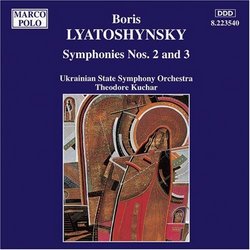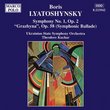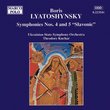| All Artists: Boris Mykolayovich Lyatoshyns'ky, Theodore Kuchar, Ukrainian State Symphony Orchestra Title: Lyatoshynsky: Symphonies 2 & 3 Members Wishing: 0 Total Copies: 0 Label: Marco Polo Release Date: 7/26/1994 Genre: Classical Style: Symphonies Number of Discs: 1 SwapaCD Credits: 1 UPC: 730099354028 |
Search - Boris Mykolayovich Lyatoshyns'ky, Theodore Kuchar, Ukrainian State Symphony Orchestra :: Lyatoshynsky: Symphonies 2 & 3
 | Boris Mykolayovich Lyatoshyns'ky, Theodore Kuchar, Ukrainian State Symphony Orchestra Lyatoshynsky: Symphonies 2 & 3 Genre: Classical
|
Larger Image |
CD DetailsSimilar CDs |
CD ReviewsGreat performances of works of this Great Ukrainian. David A. Hollingsworth | Washington, DC USA | 04/10/1999 (5 out of 5 stars) "Boris Nikoleyevich Liatoshynsky (1895-1968) is generally regarded as the father of contemporary Ukrainian music. Whereas his professor of composition, Reinhold Gliere, was influential upon him & others, Liatoshynsky had a greater influence upon contemporary Ukrainian composer, such as Stankovich, Silvestrov, Artyomov, & Baley. As composer, as well as professor & director of the Kiev Conservatory, Ukraine finally had its musical voice and its musical identity. Whereas Carl Nielsen was the voice of modern Danish music, Sibelius of Finland, Szymanowski of Poland, Kodaly & Bartok of Hungary, Enesco of Romania, Bax, Walton, & Vaughan-Williams of Great Britain, so was Liatoshynsky of the Ukraine.The 2nd symphony was completed by 1936 & revised by 1940 (revision forced upon the composer by the Soviet regime). In many ways, the symphony represents a turning point in Liatoshynsky's idiom & ways of communication. Whereas the 1st symphony shows considerable influences of both Gliere & Scriabin, the 2nd symphony noticeably rid itself of such influences (although Gliere was still on the composer's mind to an extent)& what we have is Liatoshynsky in his own, identifiable language. His sense of communicative urgency & daringnes are apparent in this symphony as well in symphonies nos. 1 & 3: they somewhat disappeared in his 4th & 5th symphonies. The second symphony is an outcry of repression placed upon him & other composers during the Age of Stalin, (like Popov's 1st & Shostakovich 4th symphonies, though lesser in extent). I am willing to believe that the 1st version of Liatoshynsky's symphony no. 2 is more darker, angered, & honest in tone than the "forced" 2nd version. Nevertheless, this work is regarded as highly as the symphonies of Shostakovich, Prokofiev, & Myaskovsky.The Third Symphony of 1951, revised under orders of the Soviet censors in 1954, is the most popular of Liatoshynsky's five symphonies. The first movement is one of anger & tragedy whereas the second movement is both beautiful & mournful. The 3rd movement is joyful & optimistic while the 4th movement is triumphal. The composer used the epigraph "Peace will defeat war" in the last movement of the original score, until he was forced to remove it. A terrible misfortune, since the epigraph very likely to have meant "Free living, free thinking minds will defeat repression." Listening to the finale, there is nothing wrong to assume that overcoming repression was on the composer's mind when composing the 3rd symphony. Does this reminds you of Kodaly's Psalmus Hungaricus?The performances of the Ukrainian State Symphony under Theodore Kuchar show high emotionism, commitment, & pride in performing the works of their countryman. The recording is full & liveliness. Highly Recommendable & a first choice over the recordings of the same works in Russian Disc compact disc recordings.Should I hope for the same conductor, ensemble team to perform & record in the future, more of Liatoshynsky's works, such as his Slavonic Concerto for piano & orchestra, Suite "Romeo & Juliet" & other obsured & unrecorded works (like his Operas "The Golden Ring" & "Schchors")?"
|

 Track Listings (7) - Disc #1
Track Listings (7) - Disc #1
